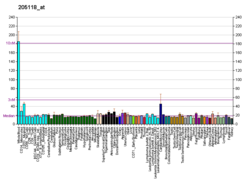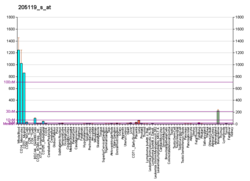Human
In early studies, cultured human HL-60 promyelocytes purposely differentiated to granulocytes were used to partially purify [10] and in a series of experiments clone FPR1; [11] [12] [13] [14] [15] an apparent homolog of FPR1, Fpr was also cloned from rabbit neutrophils. [16] The studies indicated that FPR1 is a G protein-coupled receptor that activates cells though a linkage to the pertussis toxin-sensitive Gαi subclass of G proteins, that FPR1 is located on chromosome 19q.13.3, and that this gene consists of two exons, the first of which encodes a 66 base pair 5'-untranslated sequence, the second of which has an intronless open reading frame coding for a protein containing ~354 amino acids; the studies also indicated that cells express multiple formyl peptide receptor mRNA transcripts due to Allelic heterogeneity, alternate Polyadenylation sites, and possibly products of other genes with homology to FPR1. Subsequent studies cloned two other genes with homology to FPR1 viz., FPL2 (originally termed FPR1, FPRH1, or FPRL1) and FPR3 (originally termed FPR2, FPRH2, or FPRL2). [17] [18] [19] FPR2 and FPR3 are composed of 351 and 352 amino acids, respectively, and similar to FPR1 have intronless open reading frames which encode G protein coupled receptors; FPR2 and FPR3 have 66% and 56% amino acid sequence identity with FPR1 and 72% homology to each other. [7] All three genes localize to chromosome 19q.13.3 in the order of FPR1, FPR2, and FPR3 to form a cluster which also includes the gene for another G protein-coupled chemotactic factor receptor, the C5a receptor (also termed CD88), which binds and is activated by complement component 5a (C5a) and GPR77, a second C5a anaphylatoxin chemotactic receptor C5a2 (C5L2), a second C5a receptor of debated function which has the structure of a G protein coupled receptor but fails to couple to G proteins. [20] These points are of interest because C5a is generated by the interaction of bacteria with blood plasma components to activate the complement cascade which then cleave C5a from Complement component 5. Thus, bacteria produce a family of oligopeptide chemotactic factors plus activate host complement pathways to generate C5a, which, like the formylated oligopeptides, is a neutrophil chemotactic factor that operates through receptors whose genes cluster with those for the three formyl peptide receptors. [21] Furthermore, bacteria-induced complement activation also causes the formation of complement component 3a (C3a) by cleavage from complement component 3; C3a is a neutrophil chemotactic factor which operates through a G protein coupled chemotactic factor receptor, the C3a receptor, whose gene is located at chromosome 12p13; C3a also acts through C5L2. [20] [22]
Mouse
Mouse formyl peptide receptor genes localize to chromosome 17A3.2 in the following order: Fpr1, Fpr-rs2 (or fpr2), Fpr-rs1 (or Lxa4R), Fpr-rs4, Fpr-rs7, Fpr-rs6, and Fpr-rs3; Pseudogenes ψFpr-rs2 and ψFpr-rs3 (or ψFpr-rs5) lie just after Fpr-rs2 and Fpr-rs1, respectively. All of the active mouse FPR receptors have ≥50% amino acid sequence identity with each other as well as with the three human FPR receptors. [6] Studies find that: a) mouse Fpr1 is an ortholog of human FPR1, responding to many bacterial- and mitochondrial-derived formyl peptides but only minimally to FMLP and having certain pharmacologic properties in common with human FPR2/ALX; b) mouse Fpr2 and mFpr-rs1 bind with high affinity and respond to lipoxins but have little affinity for or responsiveness to formyl peptides and therefore share key properties with human FPR2/ALX; and c) based on its predominantly intracellular distribution, mFpr-rs1 correlates, and therefore may share functionally, with human FPR3; [23] [24] [25]
The ψFpr-rs2 gene contains a deletion and frame shift which renders its protein 186 nucleotides shorter but 98% identical to the protein encoded by its closest paralog gene, Fpr-rs2. Since ψFpr-rs2 transcripts are expressed and inducible in multiple mouse tissues and since gene knockout studies ascribe functionality to it, ψFpr-rs2 may not a true pseudogene and, it is suggested, should be renamed Fpr-rs8. [26]
Fpr-rs1, Fpr-rs3, Fpr-rs4, Fpr-rs6, and Fpr-rs7 receptors are expressed in the olfactory bulb sensory neurons of the Vomeronasal organ where they have been shown to respond to their known ligands, FMLP and lipoxin A4. Isolated mouse Olfactory bulb neurons also respond to a range of other fpr agonists. These results suggest that the cited receptors function to allow the olfactory-based detection of various contaminated compounds such as spoiled food and/or their many inflammation-regulating and other agonists in bodily secretions. [27]
Gene knockout studies
The large number of mouse compared to human FPR receptors makes it difficult to extrapolate human FPR1 functions based on genetic (e.g. gene knockout or forced overexpression) or other experimental manipulations of FPR receptors in mice. In any event, targeted disruption of the Fpr1 gene reduced the ability of mice to survive intravenous injection of the bacterial pathogen, listeria monocytogenes ; [28] disruption of the Fpr2 gene in mice produce a similar effect while disruption of both genes further lowered the survival of mice to the listeria challenge. [29] The effect of these gene knockouts appeared due to faulty leukocyte function and other causes leading to a breakdown in the innate immune response. The functions of the human FPR1 receptor may be equivalent to the overlapping functions of the mouse Fpr1 and Fpr2 functions and therefore be critical in the defense against at least certain bacteria. Targeted disruption of FPR-rs1 produced a 33% reduction in the lifetime of mice; there was no specific pathology associated with this reduction. [26]





